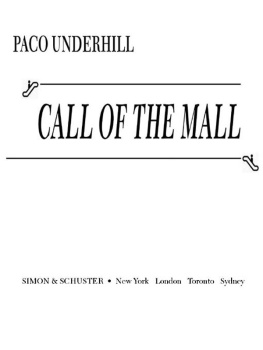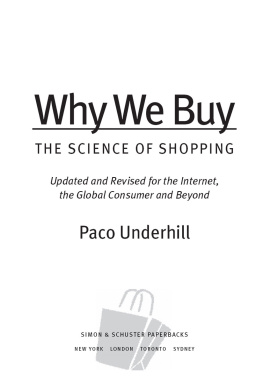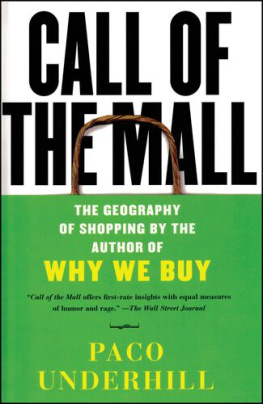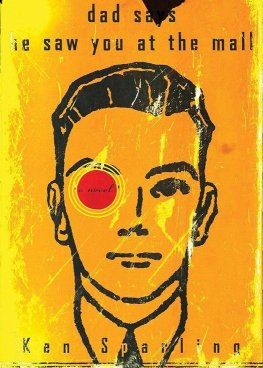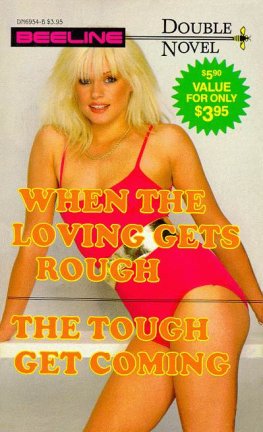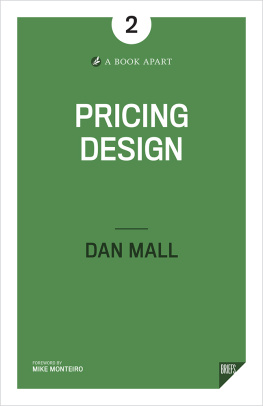SIMON & SCHUSTER
Rockefeller Center
1230 Avenue of the Americas
New York, NY 10020
Copyright 2004 by YOBOW, INC.
All rights reserved,
including the right of reproduction
in whole or in part in any form.
SIMON & SCHUSTER and colophon are registered trademarks
of Simon & Schuster, Inc.
Designed by Leslie Phillips
LIBRARY OF CONGRESS CATALOGING-IN-PUBLICATION DATA
Underhill, Paco.
Call of the mall / Paco Underhill.
p. cm.
1. Shopping mallsUnited States. 2. Consumption (Economics)United States.
3. ConsumersUnited StatesAttitudes. I. Title.
HF5430.3.U53 2004
306.30973dc22 2003064960
ISBN-13: 978-0-7432-5829-6
ISBN-10: 0-7432-5829-0
Visit us on the World Wide Web:
www.SimonSays.com
Generation 3 at Envirosell has been a good one.
Jenny Bonilla
Bob Bowman
Robyn Cushing
Diana Dawson
Kerry Elsasser
Gustavo Gomez
Dave Guerdette
Delise Dupont Jackson
Mark Pingol
Hillary Ross
Adrienne Sforza
Jennifer Vondrak
Contents
Prologue
W HY ARE we here?
Were here to buy stuff.
Were here because were bored.
Were here because tomorrows Mothers Day.
Were here for the new Avril Lavigne CD.
Were here for emancipation.
Were here for lip gloss.
Were here because our mom made us come.
Were looking for sheets and towels.
Were looking for sex and love.
Were looking for self-esteem.
Were looking for jeans that fit.
Were here for our first business suit.
Were here because our daughter made us come.
Were here for a nice afternoon with the grandkids.
Were here for the food court.
Were here for the video arcade.
Were here for the movies.
Were here because its pouring.
Were here to buy sneakers.
Were here because tomorrows our anniversary.
Were here because he needs underwear.
Were here because she needs underwear.
Were here because everybody needs underwear.
Were here because theres nothing on TV.
Were here because its fun!
Were here because our wife made us come.
Were here for no reason whatsoever.
Were looking for boys.
Were looking for girls.
Were looking for work.
Were looking to shoplift.
Were here because we love the mall!
Were here because everybody else is.
Were here because Christmas is coming.
Were here because Hanukkah is coming.
Were here because Kwanzaa is coming.
We dont know why were here.
Were here to findsomething.
Were here because were here.
Introduction
A RE WE really going to spend an entire book inside a mall?
Yes, we are.
Its not as though studying people as they congregate to buy and sell things is a totally frivolous or small-minded endeavor. Consider the history of our species, a fair swath of which has been propelled by merchants or their emissaries traveling to the far reaches of the planet, sometimes at great risk, in order to bring back stuff to peddle to the rest of us. As any schoolchild can testify, the romance of the ancient world teems with spice routes and trade winds and trafficking in silks and precious metals, frankincense and myrrh, gunpowder and fur. Theoretically, we could all grow our own food and make our own clothes and build our own houses. But it would be boring. So lets agree that the saga of humankind can be told at least in part through the story of shopping.
Surely, then, youll concur that the sites of so much significant social activity might be worth a look now and then? We tend to think of the mall as a recent, primarily American phenomenon, and a rather banal one at that, born of demographic conveniencewe all bought cars and moved to the burbsrather than any profound change in who or what we are. But the mall has been with us always, under other names and in somewhat different forms. Virtually since the dawn of civilization, we have organized our world in part around the function of shopping. Even the simplest agrarian societies needed places to assemble to trade in goods, and from that basic impulse came everything elsemarketplaces, villages, towns, cities. The mall is, at heart, just an ancient organizing principle that hasnt yet outlived its usefulness. Perhaps it never will.
But its also easy to forget how recent the enclosed regional shopping mall is, maybe because it has so quickly become such a mainstay of American life. The first one popped up (in Edina, Minnesota) a mere seven decades ago, and now malls are the dominant arena of American shopping, which is itself an economic force the likes of which the world has never known. Without even meaning to, the mall has transformed our country, and not always for the good. For one thing, it drew shoppers away from vulnerable towns and big cities, and when that happened, decline usually set in. But theres no guarantee that malls will be with us forever. In fact, some evidence points to just the opposite outcome.
Whats that, you say? Youre okay with shopping but not with the mall? A common condition. Many otherwise fair-minded, intelligent people scorn and despise malls. Some still end up shopping in them on a regular basis. But theyre not proud of it. You of this opinion may not be swayed by arguments of how the mall is a contemporary version of the souks, bazaars, arcades, bourses, and markets of olden days. But by studying the mall and what goes on there, we can learn quite a lot about ourselvesabout the state of the nation and its inhabitantsfrom a variety of perspectives: economic, aesthetic, geographic, spiritual, emotional, psychological, sartorial.
I might agree with those who say that some of the adventure and romance associated with trading has been lost along the way. Somehow, the glorious history of commerce has culminated in a sanitized architectural clich in which you typically find not exquisite treasures and exotic wares but rather eighty different styles of sneaker or sixteen varieties of chocolate chip cookie. No wonder we look at the mallat the ambition of it, at the reality, at that already obese teenager stuffing her jaw with a drooling Cinnabonand we cant help but wonder: Is this the best we could do?
Its no surprise that the mall is such an easy target for American self-loathing in particular. Its a lot like television in that way: another totally fake environment that attempts to pass itself off as a true reflection of who we are and what we want. We disdain it, and yet we cant stop watching. Or shopping. Once in a while, TV fulfills its highest callingwhen a man first lands on the moon, say, or during the Watergate hearings. But most of the time it contents itself with reruns of Threes Company and infomercials for the home rotisserie.
Its the same with the mall. It could be much bettermore vivid, intelligent, adventurous, entertaining, imaginative, alive with the human quest for art and beauty and truth. But its not.
Its the mall.
1 America Shops
W ERE DRIVING toward the mall.
I spend a lot of time in malls. Too much, I think. I daydream of life on a ranch out west where Id go to Wal-Mart every two weeks for groceries, and that would be it for me and shopping.
It will never happen.
You are riding with a tall, bald, stuttering research wonk on the cusp of his fifty-third year. I am called a retail anthropologist, which makes me uncomfortable, especially around my colleagues still in academia who have many more degrees than I do. For whatever combination of reasons, Ive spent my adult life studying people shopping. I watch how they move through stores and other commercial environmentsrestaurants, banks, fast-food joints, movie theaters, car dealerships, the post office, concert halls. Even in church, I study people. It is an odd skill, not one I would have sought. Yet I am good at it, and it pays the bills. I cant imagine not doing it.

